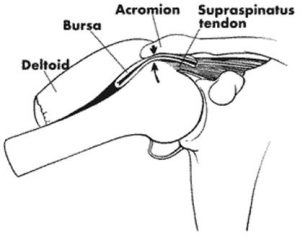Sport Rehabilitation and Physiotherapy for Shoulder Impingement

What is Shoulder Impingement Syndrome?
Pain on elevating the arm due to entrapment of structures called the bursa and rotator cuff. The rotator cuff is a small group of muscles that control and stabilise the shoulder. The bursa is a small sac of fluid that reduces friction on these tendons. There are other names for this condition such as Sub-acromial bursitis, Sub-deltoid bursitis or tendonitis of the rotator cuff muscles.
What Causes Shoulder Impingement Syndrome?
This is usually due to muscle imbalance or trauma to the rotator cuff. Movement of the arm causes the rotator cuff and bursa to be pinched leading to inflammation and swelling of the bursa. The condition may also be caused by poor posture of the neck and shoulder.
What are the symptoms of Shoulder Impingement Syndrome?
Shoulder pain particularly when lifting the arm or sleeping on the affected side. In very severe cases pain or pins and needles can radiate down the arm into the hand and may result in weakness and restriction of movement.
What treatments are most commonly used for Shoulder Impingement Syndrome?
Treatment will consist of the treatments below to reduce the inflammation and pain with an exercise / postural programme to retrain the rotator cuff and repair the imbalance.
Massage – Encompassing a variety of techniques and is given with sufficient pressure through the superficial tissue to reach the deep lying structures. It is used to increase blood flow, decrease swelling, reduce muscle spasm and promote normal tissue repair.
Taping/Strapping – May be used if thought necessary to restrict abnormal movement and prevent further damage, or to facilitate the function of the affected muscles.
Deep friction – Is an aggressive massage technique applied across the tissue fibres as deeply as possible. This technique is initially painful but can cause a numbing effect. It can be used to break down scar tissue, restore normal movement and prepare the injured structure for mobilisation.
Mobilisation – Is a manual technique where the joint and soft tissues are gently moved by the therapist to restore normal range, lubricate joint surfaces and relieve pain.
Ultrasonic therapy – Transmits sound waves through the tissues stimulating the body’s chemical reactions and therefore healing process, just as shaking a test tube in the laboratory speeds up a chemical reaction.
Interferential therapy – Introduces a small electrical current into the tissues and can be used at varying frequencies for differing treatment effects. E.g. pain relief, muscle or nerve stimulation, promoting blood flow and reducing inflammation.
What other treatments could be used for Shoulder Impingement Syndrome?
Acupuncture – An oriental technique of introducing needles into the skin to increase or decrease energy flow to promote pain relief and healing.
Injection Therapy – A specialist procedure, during which a non-harmful steroid and local anaesthetic are injected directly into the injured structure. It has a dramatic effect on removing inflammation and promoting healing.
What can you do yourself to help Shoulder Impingement Syndrome?
Exercise / Postural programme – This is the most important part of the rehabilitation. Your therapist will instruct you as to which exercises to begin with, when to add the others, as well as how to progress the exercises.
Medication – Ask your GP or Pharmacist for advice on the best medication for your condition.
Apply an ice pack – For a maximum of 20 minutes. A bag of frozen peas wrapped in a damp cloth works well because it moulds to the shape of the arm. Ensure that you do not apply ice directly to the skin as this can cause an ice burn.
Ergonomics – Ensure all your seating is encouraging good posture and your work station is set up correctly.
What if physical therapy does not help or resolve Shoulder Impingement Syndrome?
It is very rare that treatment does not give great benefit. In these cases however, a cortisone injection may be appropriate and in very extreme cases surgery is a possible option. These options can be discussed with your therapist if appropriate.
If you think you may have this condition we would love the opportunity to show you our expertise in the treatment and management of this condition so – Please click here for details of how to contact us to book an appointment
If you are unsure whether you have this condition or you would just like to speak to somebody then please get in touch here or call 0161 745 7551.
